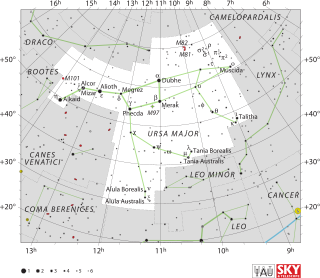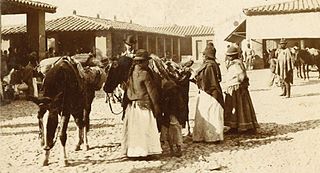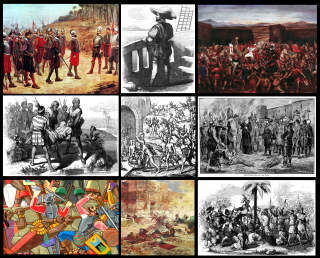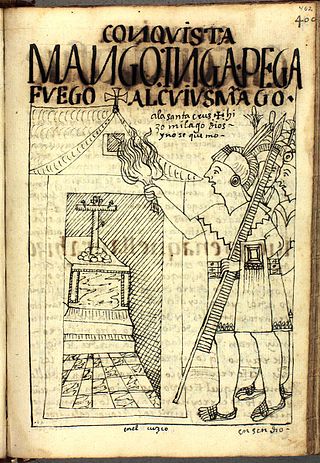Related Research Articles

A constellation is an area on the celestial sphere in which a group of visible stars forms a perceived pattern or outline, typically representing an animal, mythological subject, or inanimate object.

Crux is a constellation of the southern sky that is centred on four bright stars in a cross-shaped asterism commonly known as the Southern Cross. It lies on the southern end of the Milky Way's visible band. The name Crux is Latin for cross. Even though it is the smallest of all 88 modern constellations, Crux is among the most easily distinguished as its four main stars each have an apparent visual magnitude brighter than +2.8. It has attained a high level of cultural significance in many Southern Hemisphere states and nations.

The Inca Empire, officially known as the Realm of the Four Parts, was the largest empire in pre-Columbian America. The administrative, political, and military center of the empire was in the city of Cusco. The Inca civilization rose from the Peruvian highlands sometime in the early 13th century. The Spanish began the conquest of the Inca Empire in 1532 and by 1572, the last Inca state was fully conquered.

The llama is a domesticated South American camelid, widely used as a meat and pack animal by Andean cultures since the pre-Columbian era.

Lyra is a small constellation. It is one of the 48 listed by the 2nd century astronomer Ptolemy, and is one of the modern 88 constellations recognized by the International Astronomical Union. Lyra was often represented on star maps as a vulture or an eagle carrying a lyre, and hence is sometimes referred to as Vultur Cadens or Aquila Cadens, respectively. Beginning at the north, Lyra is bordered by Draco, Hercules, Vulpecula, and Cygnus. Lyra is nearly overhead in temperate northern latitudes shortly after midnight at the start of summer. From the equator to about the 40th parallel south it is visible low in the northern sky during the same months.

Ursa Major, also known as the Great Bear, is a constellation in the northern sky, whose associated mythology likely dates back into prehistory. Its Latin name means "greater bear", referring to and contrasting it with nearby Ursa Minor, the lesser bear. In antiquity, it was one of the original 48 constellations listed by Ptolemy in the 2nd century AD, drawing on earlier works by Greek, Egyptian, Babylonian, and Assyrian astronomers. Today it is the third largest of the 88 modern constellations.
Year 1471 (MCDLXXI) was a common year starting on Tuesday of the Julian calendar.

Machu Picchu is a 15th-century Inca citadel located in the Eastern Cordillera of southern Peru on a mountain ridge at 2,430 meters (7,970 ft). Often referred to as the "Lost City of the Incas", it is the most familiar icon of the Inca Empire. It is located in the Machupicchu District within Urubamba Province above the Sacred Valley, which is 80 kilometers (50 mi) northwest of Cusco. The Urubamba River flows past it, cutting through the Cordillera and creating a canyon with a subtropical mountain climate.

Lake Titicaca is a large freshwater lake in the Andes mountains on the border of Bolivia and Peru. It is often called the highest navigable lake in the world. Titicaca is the largest lake in South America both in terms of the volume of water and surface area. It has a surface elevation of 3,812 m (12,507 ft).

The Coalsack Nebula is a dark nebula, which is visible to the naked eye as a dark patch obscuring part of the Milky Way east of Acrux in the constellation of Crux.

The Aymara or Aimara, people are an indigenous people in the Andes and Altiplano regions of South America. Approximately 2.3 million Aymara live in northwest Argentina, Bolivia, Chile, and Peru. The ancestors of the Aymara lived in the region for many centuries before becoming a subject people of the Inca Empire in the late 15th or early 16th century, and later of the Spanish in the 16th century. With the Spanish American wars of independence (1810–1825), the Aymaras became subjects of the new nations of Bolivia and Peru. After the War of the Pacific (1879–1883), Chile annexed territory with the Aymara population.

Quipu are recording devices fashioned from strings historically used by a number of cultures in the central Andes Mountains of South America.

The Spanish conquest of the Inca Empire, also known as the Conquest of Peru, was one of the most important campaigns in the Spanish colonization of the Americas. After years of preliminary exploration and military skirmishes, 168 Spanish soldiers under conquistador Francisco Pizarro, along with his brothers in arms and their indigenous allies, captured the Sapa Inca Atahualpa in the 1532 Battle of Cajamarca. It was the first step in a long campaign that took decades of fighting but ended in Spanish victory in 1572 and colonization of the region as the Viceroyalty of Peru. The conquest of the Inca Empire, led to spin-off campaigns into present-day Chile and Colombia, as well as expeditions to the Amazon Basin and surrounding rainforest.

The Inca religion was a group of beliefs and rites that were related to a mythological system evolving from pre-Inca times to Inca Empire. Faith in the Tawantinsuyu was manifested in every aspect of his life, work, festivities, ceremonies, etc. They were polytheists and there were local, regional and pan-regional divinities.

The Inca society was the society of the Inca civilization in Peru. The Inca Empire, which lasted from 1438 to 1533 A.D., represented the height of this civilization. The Inca state was known as the Kingdom of Cusco before 1438. Over the course of the empire, the rulers used conquest and peaceful assimilation to incorporate a large portion of western South America, centered on the Andes mountain ranges. The empire proved relatively short-lived however: by 1533, Atahualpa, the last Sapa Inca (emperor) of the Inca Empire, was killed on the orders of the conquistador Francisco Pizarro, marking the beginning of Spanish rule. The last Inca stronghold, the Neo-Inca State in Vilcabamba, was conquered by the Spanish in 1572.

Coricancha, Curicancha, Koricancha, Qoricancha or Qorikancha was the most important temple in the Inca Empire, and was described by early Spanish colonialists. It is located in Cusco, Peru, which was the capital of the empire.

The 10-month siege of Cusco by the Inca army under the command of Sapa Inca Manco Inca Yupanqui started on 6 May 1536 and ended in March 1537. The city was held by a garrison of Spanish conquistadors and Indian auxiliaries led by Hernando Pizarro. The Incas hoped to restore their empire (1438–1533) with this action, but it was ultimately unsuccessful.

Inca cuisine originated in pre-Columbian times within the Inca civilization from the 13th to the 16th century. The Inca civilization stretched across many regions on the western coast of South America, and so there was a great diversity of unique plants and animals used for food. The most important plant staples involved various tubers, roots, and grains; and the most common sources of meat were guinea pigs, llamas, fish, and other aquatic and terrestrial organisms (305-307). Cuisine was heavily influenced by the Inca's food storage system, social gatherings and celebrations, and social status (308-315).

Inca mythology is the universe of legends and collective memory of the Inca civilization, which took place in the current territories of Colombia, Ecuador, Peru, Bolivia, Chile, and Argentina, incorporating in the first instance, systematically, the territories of the central highlands of Peru to the north.

The Andean civilizations were South American complex societies of many indigenous people. They stretched down the spine of the Andes for 4,000 km (2,500 mi) from southern Colombia, to Ecuador and Peru, including the deserts of coastal Peru, to north Chile and northwest Argentina. Archaeologists believe that Andean civilizations first developed on the narrow coastal plain of the Pacific Ocean. The Caral or Norte Chico civilization of coastal Peru is the oldest known civilization in the Americas, dating back to 3500 BCE. Andean civilizations are one of at least five civilizations in the world deemed by scholars to be "pristine." The concept of a "pristine" civilization refers to a civilization that has developed independently of external influences and is not a derivative of other civilizations.
References
- ↑ Freeman, Benjamin, ed. (13 July 2022). "AP WORLD PEOPLE TO KNOW". Freemanpedia. Retrieved 2023-06-18.
- ↑ D'Altroy, Terence N. (2002). The Incas . The Peoples of America. Oxford: Blackwell Publishing. p. 149. ISBN 978-0-631-17677-0.
- ↑ Prieto, Andres I. (2011-03-28). Missionary Scientists: Jesuit Science in Spanish South America, 1570-1810. Vanderbilt University Press. p. 110. ISBN 978-0-8265-1744-9.
- ↑ Dahle, H. "Orion raising over petroglyphs". European Southern Observatory . Retrieved 2023-06-18.
